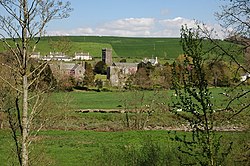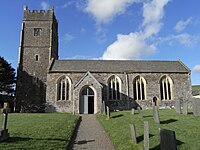Weare Giffard
| Weare Giffard | |
| Devon | |
|---|---|
 Weare Giffard church and hall | |
| Location | |
| Grid reference: | SS467220 |
| Location: | 50°58’40"N, 4°11’4"W |
| Data | |
| Postcode: | EX39 |
| Local Government | |
| Council: | Torridge |
| Parliamentary constituency: |
Torridge and North Devon |
Weare Giffard is a small and diffuse village in north Devon, on the east bank of the River Torridge, downstream of Great Torrington and just above the point where the river becomes tidal. The old heart of the village is at the church and manor house, in a bend in the river, though most of its houses are found half a mile to the east along the one road. Weare Giffard is to be found two and a half miles north-west of Great Torrington.
The village gains the suffix of its name from the Giffard family, who owned the manor until the end of the thirteenth or the early fourteenth century. The name 'Weare' appears to refer to fish-wears placed in the River Torridge here.
Parish church
The parish church, the Church of the Holy Trinity, stands west of the main knot of houses of Weare Giffard, on a hillside to the north and slightly above the wide and flat valley floor of the River Torridge. The church is a Grade I listed building.
History
The historian of Devon Tristram Risdon (d.1640)[1] supposed the name Weare to be derived from a fish weir which was historically situated in the river to catch fish. The construction of a fish-weir generally required a licence from the feudal overlord, as naturally these affected the catches of other inhabitants further along the river. Many disputes are recorded in the mediæval records over disputes concerning fish-weirs.
One of the earliest holders of the manor was the 13th-century Sir Walter Giffard, after whom the manor subsequently took its suffix, who lived during the reign of King Henry III (1216–1272). He left a daughter Emma as his sole heiress who married thrice. Stone effigies of an early member of the Giffard family and his wife are to be seen in the parish church
The Trewin or Treawyn family, alias "de Weare", later owned the manor. The last of in the male line was William de Wear, who died c. 1421 and left a daughter his sole heiress, who became the wife of Richard Denzell, and the manor descended to their heirs. In 1454, Sir Martin Fortescue, second son of Sir John Fortescue, the Chief Justice, married Elizabeth Densyll, the daughter and heiress of Richard Densyll of Weare Giffard and Filleigh. Their union joined several Devon estates. The Filleigh Estate, comprising some 5,500 acres, together with Castle Hill mansion is still today privately owned by descendants of the Fortescue family. Hugh Fortescue, 5th Earl Fortescue (1888–1958) bequeathed Weare Giffard to his younger daughter Lady Elizabeth Fortescue (b. 1926),[2] later Baxendale, who sold the manor in 1960..[3]
Weare Giffard Hall
Weare Giffard Hall was described thus by Sabine Baring-Gould:[4]
"In approaching the house, we have on our left the square gateway tower, and enter, by a low modern Gothic porch, the entrance hall. Above the fireplace are two oak carvings of the Adoration of the Magi and the Resurrection. The walls of the hall are lined with tapestry. The best view of the hall roof is obtained from the gallery. The north wall is ornamented with three full-length portraits in the style of Sir Peter Lely, and some Elizabethan medallions. On the south wall are three coats-of-arms in relief: the Royal arms, dating 1599; on the right, the Bedford; on the left, those of Bourchier, Earl of Bath. To the height of 10 ft. the walls are panelled with richly carved oak. There are several rooms with interesting fireplaces".
See also
Outside links
| ("Wikimedia Commons" has material about Weare Giffard) |
- "The Giffards and Fortescues", www.wearegiffard.info
- "The Giffard and Fortescue Family Line Relating to Our Village", www.wearegiffard.info
References
- ↑ Risdon, Tristram: 'A Survey of Devon' (1632), 1810 edition, p 278
- ↑ Lauder, R., op.cit. p.80
- ↑ WeareGiffard.Info
- ↑ Baring-Gould, Sabine, "Devon"
- Risdon, Tristram: 'A Survey of Devon' (1632), 1810 edition, p 891–893
- Lauder, Rosemary, Devon Families, Tiverton, 2002, Fortescue, pp. 75–82
- Ashworth, E. The Ancient Manor House of Weare Giffard (1858)
- Country Life Magazine, 2 January 1915

